 By Bob Currie, Vessel Examiner
By Bob Currie, Vessel Examiner
United States Coast Guard Auxiliary Flotilla 081-06-08
In August 2017, three men, two of whom I graduated from high school with, were fishing the Louisiana side of Sabine Lake in the area of Green’s Bayou when they hit a submerged pipe. This column concerns the events of the accident, the aftermath reporting of the accident, and the costs involved with the repairs to the boat. In addition, I made some recommendations to my friend on how to help avoid such an accident in the future, as well as recommendations for safer boating.
Flotilla 081-06-08 is based at Coast Guard Station Galveston. The Coast Guard Auxiliary is the uniformed civilian component of the US Coast Guard and supports the Coast Guard in nearly all mission areas. The Auxiliary was created by Congress in 1939. For more information, please visit www.cgaux.org.
The Accident
The boat owner, Robert, had owned the boat only about three months when the accident occurred. The boat was a 22-foot center console fishing boat powered by a 250 HP engine, and it was equipped with a GPS chart plotter/sonar combination. 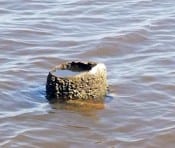 Robert said he was more familiar with the sonar and was using that rather than the chart plotter option at the time of the accident. I asked him if he had noticed anything on the sonar that might have warned him of something just below the waterline, and he said no, all aboard were scanning the horizon for birds working the water. They were fishing in the area of Green’s Bayou, which is along the Louisiana shoreline, thus they were under the jurisdiction of Louisiana Department of Wildlife and Fisheries (LDWF). They had eased into Green’s Bayou and fished for awhile, and were on their way out into Sabine Lake when they hit the pipe shown in the picture. The pipe was submerged at the time they hit it. Robert later went back at low tide and took the picture and obtained the GPS coordinates in order to complete the Coast Guard Boating Accident Form sent to them by the LDWF.
Robert said he was more familiar with the sonar and was using that rather than the chart plotter option at the time of the accident. I asked him if he had noticed anything on the sonar that might have warned him of something just below the waterline, and he said no, all aboard were scanning the horizon for birds working the water. They were fishing in the area of Green’s Bayou, which is along the Louisiana shoreline, thus they were under the jurisdiction of Louisiana Department of Wildlife and Fisheries (LDWF). They had eased into Green’s Bayou and fished for awhile, and were on their way out into Sabine Lake when they hit the pipe shown in the picture. The pipe was submerged at the time they hit it. Robert later went back at low tide and took the picture and obtained the GPS coordinates in order to complete the Coast Guard Boating Accident Form sent to them by the LDWF.
Robert said they were maneuvering slowly out of the bayou so that their wake did not bother another fisherman fishing in the mouth of the bayou. The fisherman waved to them signaling that they were free to accelerate without affecting him. Robert said he moved the throttle forward, and they had moved only a short distance when the boat came to a sudden stop. The engine was thrust up out of the water, but the transom didn’t appear to be damaged, so Robert made the decision to run back to the ramp as quickly as possible on the assumption that the hull had been breached. They made it back to the ramp and were able to put the boat on the trailer. The following pictures show the damage to the hull, the lower unit, and the propeller.
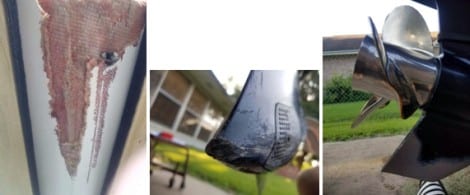
Interestingly enough, the boat ran smoothly back to the ramp with no hint of the serious damage inflicted by the submerged pipe. It was only after they got the boat onto the trailer that they found out how badly it was damaged, as water poured from the gash in the hull for quite some time after the boat was pulled from the water.
Aftermath Reporting
Robert had two calls to make when he got the boat home. The first was to the LDWF emergency reporting number, and the second was to his boat insurance agent. Although insurance is not required in Texas or Louisiana, it is highly recommended that it be obtained. The LDWF sergeant that Robert talked to took the information regarding the accident, then sent Robert the Coast Guard Recreational Boating Accident Report and told him that all persons aboard had to complete the form. This form is required whenever the accident:
- Results in death (within 48 hours); or
- At least one person involved in this accident disappeared and has not been recovered; or
- Results in injuries to a person requiring medical treatment beyond first aid; or
- Causes damage to vessel(s) or property in excess of $2,000.00.
In Robert’s case, it was quite obvious that over $2,000.00 in damage had occurred.
Damage and Repairs
Robert was instructed to select a shop to complete the repairs and have them submit an estimate. The shop estimated the boat to have $9,000 in damage to the hull and an additional $5,000 damage to the lower unit and prop. It was October before all reporting and estimates were complete. Robert found his boat to be in a line of boats waiting for fiberglass repairs. The dealer repaired the lower unit at a cost of $5,100, and the prop was repaired for $500. By now the area was in the throes of a very hard winter, and the repairs to the fiberglass could not be done due to the cold. The boat sat for months waiting for warmer temperatures and its turn in line. Robert said that the hull damage was 11 layers of fiberglass deep, and the fiberglass repair company had great difficulty in drying out those damaged layers so that the repairs could be made, and the final cost for fiberglass repair was $11,000. It is now June, 10 months after the accident. The fiberglass repairs and engine repairs have been completed, and the repair company told Robert it was time to make a test ride. When he put the boat in the water for the test, the engine was running very poorly. It seems that during the long layup the gas soured, and at this point Robert is faced with additional repairs to the engine due to the bad gas. He still doesn’t have his boat back.
My Recommendation: Life Jackets
I asked Robert what safety equipment he had on his boat, such as life jackets, marine radio, and GPS/sonar. Robert said he did have life jackets aboard, but no one was wearing them. I thanked him for his honesty and asked why. He said the life jackets they had were hot due to the summer heat and no wind. I recommended that he obtain some automatic inflating life jackets. That is what my fishing partners and I wear, and they are not hot like the full sized jackets that Robert had on his boat. I asked Robert to imagine what would have happened had he hit the submerged pipe at a higher speed. He said he would definitely obtain some self-inflating life jackets after thinking of the possible consequences.
My Recommendation: Marine Radio
Robert said he did not have a marine radio, but did have cell phones. He immediately realized without my saying so that cell phone coverage on the water is spotty at best. I told him he could obtain a good marine radio capable of transmitting a distress signal to the Coast Guard for around $200. I explained the Digital Selective Calling System and the Coast Guard Rescue 21 system to him, and I think he will be making a radio purchase once he gets his boat out of repairs.
My Recommendation: Charts and Sonar
Robert admitted that everyone was watching for birds and no one was paying attention to the sonar. I recommended to Robert to split his screen so that one half displays the chart plotter and the other half displays the sonar reading. That is what I do on my boat. 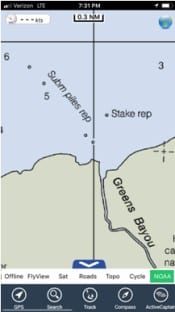 I also recommended that he become more familiar with the chart plotter function and the warning alarms that come with it. Had he been using his GPS chart plotter, he would have seen the warning about submerged pipes near the Green’s Bayou entrance, as seen from a screen shot from one of my chart plotters below.
I also recommended that he become more familiar with the chart plotter function and the warning alarms that come with it. Had he been using his GPS chart plotter, he would have seen the warning about submerged pipes near the Green’s Bayou entrance, as seen from a screen shot from one of my chart plotters below.
In addition to using his on board GPS chart plotter and paying attention to it, I also recommended to Robert that he obtain a fishing chart of the areas he planned to navigate. Such fishing charts list the hazards and for some hazards give their GPS coordinates, thus allowing you to make waypoints for such hazards and attach proximity warnings to those coordinates. In addition, such charts give detailed warnings to fishermen such as the warning below.
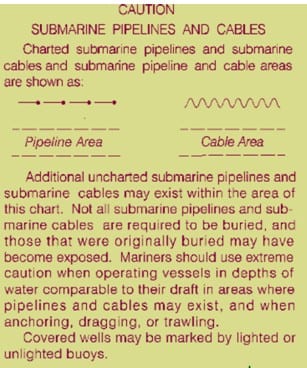
Summary
There is Boating and there is Safe Boating. Safe Boating requires knowledge and preparation. Having the proper safety equipment is not enough. You must know the equipment and you must use the equipment.
For more information on boating safety, please visit the Official Website of the U.S. Coast Guard’s Boating Safety Division at www.uscgboating.org. Questions about the US Coast Guard Auxiliary or our free Vessel Safety Check program may be directed to me at [email protected]. I am available to perform free Vessel Safety Checks, and I will come to your location to perform them. SAFE BOATING!
[6-11-2018]

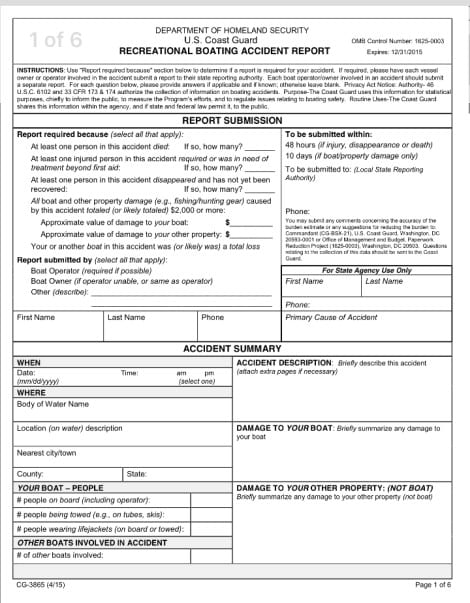
 Posted in
Posted in 
























